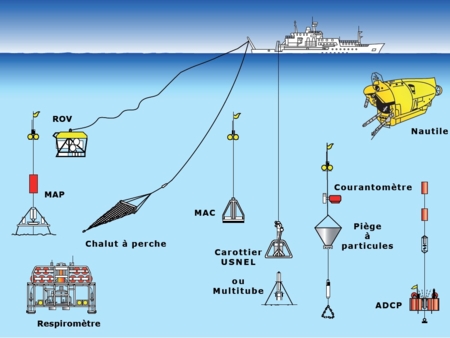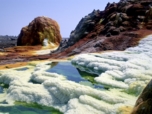In the movies
The world of deep-sea exploration sometimes combines with that of the small screen to produce documentary programmes in which the LM2E plays an active part.
Movie realized by Jean-Yves COLLET (52 min)
In the summer of 2013, the "Pourquoi Pas", IFREMER's flagship, is sailing 200 nautical miles southwest of the Azores, in the heart of the Atlantic Ocean. The 32 scientists on board are off to study the unlikely animals that live in the hot, toxic geyser sites of Lucky Strike (1700 metres deep) and Rainbow (2300 metres).
The exceptional technical capabilities of the remote-controlled robot VICTOR 6000, and the use of a revolutionary aquarium capable of maintaining the high pressures of the abyss on the ship, will enable them to carry out an extraordinary exploration in search of secrets buried since the dawn of time under kilometres of water.
The film reveals the mystery of survival for these extreme animals, which thrive against all odds thanks to the incredible symbioses they have established with bacteria perfectly adapted to the ultimate living conditions of the abyssal geysers.
Thanks to a self-contained HD camera in a titanium housing that can withstand the high pressures of the deep sea, the production team was able to shoot never-before-seen footage of the robot in the abyss, revealing surprising scenes of life in the deep geyser fauna.
Movie realized by Thierry BERROD (50 min)
Above 50 degrees, life quickly becomes extreme. To survive, some animals have strange adaptations. In the hottest parts of the world, scientists are studying how life has developed between 50 and 120 degrees. In the heart of the Sahara desert, the silver ant patrols in the middle of the day when the ground temperature is over 50 degrees. It is the only animal on earth whose body temperature can rise to 54 degrees.
Thermophilic bacteria, i.e. bacteria that can only live at high temperatures, were first observed in the hot springs of Yellowstone in the USA. To live, bacteria, like plants, draw their energy from the sun, a bio-energetic process known as photosynthesis. Since photosynthesis stops at 72 degrees, most thermophiles use chemosynthesis, using hydrogen or even arsenic. Some flies lay eggs in the microbial mats of Yellowstone. Their larvae are able to withstand temperatures of over 40 degrees. They even absorb thermophilic bacteria that settle in their digestive tract. These bacteria protect them from the mercury contained in the algae they feed on.
The hottest places on the planet are found at the bottom of the oceans. Hot springs bubble up near ocean ridges at over three hundred degrees. The study of thermophilic or hyperthermophilic organisms has led to many biotechnological advances. It is thanks to them that we are now able to amplify DNA or synthesise new molecules for the pharmaceutical industry.
Bacteria of Darkness
Film directed by Alain LABOUZE (14 min)
Deep in the oceans, hot springs of water rich in methane and hydrogen sulphide have allowed the development of bacteria which in turn feed shrimps and other marine animals, making it possible to create particularly original biotopes. Other bacteria live in the porous chimneys from which hydrothermal fluids escape at temperatures that can exceed 350°. They can withstand very high pressure and temperature conditions, which is why they have been called thermophilic or hyperthermophilic bacteria.
Daniel Prieur, a researcher at the Marine Microbiology Laboratory in Roscoff, is studying these microorganisms to understand how they can survive in these extreme conditions. We know, for example, that their DNA is protected and compacted by special enzymes, but many problems remain to be solved.
Movie realized by Alain LABOUZE (14 min)
Deep in the oceans, hot springs of water rich in methane and hydrogen sulphide have allowed the development of bacteria which in turn feed shrimps and other marine animals, making it possible to create particularly original biotopes. Other bacteria live in the porous chimneys from which hydrothermal fluids escape at temperatures that can exceed 350°. They can withstand very high pressure and temperature conditions, which is why they have been called thermophilic or hyperthermophilic bacteria.
Daniel Prieur, a researcher at the Marine Microbiology Laboratory in Roscoff, is studying these microorganisms to understand how they can survive in these extreme conditions. We know, for example, that their DNA is protected and compacted by special enzymes, but many problems remain to be solved.









